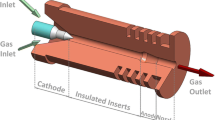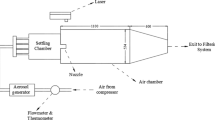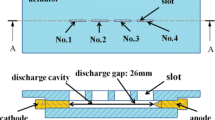Abstract
This study was undertaken to examine the mechanisms which produce the large entrainment measured at the exit of thermal plasma torches. The experiments studied a Metco 7MB plasma torch with a 706 (6.35 mm diameter) anode nozzle and swirled argon gas injection. The vortex structure produced in the shear layer of the plasma jet was visualized using a laser shadowgraph system with a short exposure lime (10−4 s). A high-speed video system provided information on the structure and unsteadiness of the hot potential core of the plume. Tile shear layer visualizations were compared to previous measurements of acoustical power spectra and indicate coherent vortex structure formation at low gas flowrates. At higher gas flowrates the shear layer rapidly broke down, producing relatively small scale turbulence. The visualizations of the hot potential core were compared to previous measurements of the torch voltage fluctuations caused by arc instabilities. At low flowrates the arc-produced voltage fluctuations were guile low card the phone was very steady. At higher flowrates the voltage fluctuations increased and produced “surging ” and “whipping” in the hot potential core.
Similar content being viewed by others
References
E. Pfender, J. R. Fincke, and R. Spores.Plasma Chem. Plasma Process. 11, 529 (1991).
S. Russ and E. Pfender. “Effect of Gas Entrainment on Particle Heating in a Turbulent Plasma Jet,”Heat Transfer in Plasma Processing, ASME HTD, Vol. 161 (1991 ).
J. R. Fincke and W. D. Swank. “The Effect of Plasma Jet Fluctuations on Particle Time-Temperature Histories.”Proceedings of the 1991 ASM National Thermal Spray Conference, Pittsburgh, Pennsylvania, 1991, p. 193.
R. Spores. “Analysis of the Flow Structure of a Turbulent Thermal Plasma Jet,” Ph.D. Thesis, University of Minnesota, 1989.
D. Kyle. “The Instability and Breakdown of a Round Variable Density Jet.” Ph.D. Thesis, Yale University. 1991.
S. Russ, “Turbulence and Entrainment in Plasma and Heated Jets.” Ph.D. Thesis. University of Minnesota. 1993.
J. R. Fincke and C. G. Pentecost, “Laminar-to-Turbulent Transitions and Entrainment in Thermal Plasma Jets.”Heat Transfer in Plasma Processing, ASME HTD. Vol. 161 (1991).
S. Wutzke, “Conditions Governing the Symptomatic Behavior of an Electric Arc in a Super-imposed Flow Field.” Ph.D. Thesis, University of Minnesota, 1967.
M. Brossa and E. Plender,Plasma Chem. Plasma Process. 8, 75 (1988).
Author information
Authors and Affiliations
Rights and permissions
About this article
Cite this article
Russ, S., Pfender, E. & Strykowski, P.J. Unsteadiness and mixing in thermal plasma jets. Plasma Chem Plasma Process 14, 425–436 (1994). https://doi.org/10.1007/BF01570205
Received:
Revised:
Published:
Issue Date:
DOI: https://doi.org/10.1007/BF01570205




